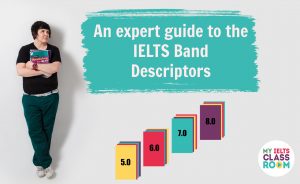
Do I need to include my opinion in the introduction to an IELTS Discuss Both Sides essay?
This is the question I see most often on social media, and the one that shows me that IELTS students are focussing their preparation in the wrong place! In today’s blog, I won’t just answer this question, but I’ll explain the logic behind my answer, so you can clear your confusion forever and never need to ask it again! First, let’s spend a couple of minutes thinking about what good introductions to essays need to do.
Introductions to Essays
So, let’s forget for a moment that we are studying for IELTS and think about introductions to essays in general. If you have studied any English for Academic Purposes course, you will know that GOOD INTRODUCTIONS DO THREE THINGS:
- create interest
- introduce the general topic of the essay
- introduce the specific topic of the essay
In EAP classrooms, it’s very common to use the illustration of a funnel to show how a good introduction should work:

You start with general statements about the topic to gain the readers attention and let them know what the overall theme of the essay will be. Then, as the introduction progresses, these sentences become and more and more specific until finally you end with the thesis statement, which is the most specific sentence in your introduction. It is also the most important sentence in your whole essay as it tells the reader EXACTLY WHAT THEY WHOULD EXPECT TO READ. So, what type of information should a thesis statement include? Well, that depends!
- it should state the SPECIFIC TOPIC of the essay
- it may list the specific subtopics of the main topic that will be discussed
- it may indicate the pattern of organisation of the essay
Let me give you an example. Imagine that you are asked to write an essay about the reasons for culture shock. A good funnel introduction might look like this:
Moving to a new country can be an exciting experience that offers many new opportunities. Visiting new sites, eating exotic foods and living in a different climate can all stimulate your senses. However, once the initial delight of being way from home has worn off, being faced with new sites and sounds can often lead to people suffering from a feeling of alienation and detachment. Although not everybody experiences culture shock in the same way, I believe that it has three root causes.
If we break this simple introduction down, we can see that it definitely starts with the most general statements and ends with the most specific:
- Sentence 1 introduces the general theme of the topic (moving to another country)
- Sentence 2 gives some general examples of experiencing new things when you move (but doesn’t yet introduce that these can be negative)
- Sentence 3 introduces the idea of culture shock (but doesn’t yet say that we will be discussing its causes in the essay)
- Sentence 4 (Thesis Statement) makes it clear that this essay is about the CAUSES OF CULTURE SHOCK (i.e. not the symptoms, not the ways to cure it, not the way to avoid it, but the CAUSES)
For an academic essay, this is pretty much the perfect introduction. However, as you should already know, IELTS ESSAYS ARE NOT THE SAME AS THE ACADEMIC ESSAYS WE WRITE AT UNIVERSITY!
How IELTS Essays are Different to University Essays
Yes, IELTS essays are a particular type of essay not found anywhere else! This is one of the reasons why many students struggle to get a high scores even when they have a good level of English and good academic skills. You can find out more about the differences in my Introduction to IELTS Essays lesson, but for this blog, the two most important differences are:
1. IELTS essays are shorter, so so should your introduction be!
At university, your introduction paragraph could be anywhere from 3 to 4 sentences, or 10 to 15! However, in an IELTS essay we only have 250 words to introduce the essay, express our opinion, defend it, and conclude. That is NOT MANY! Therefore, we don’t have space in our introductions to “create interest” in the topic. I always tell my students that the examiner has been paid to be interested in your essay, so don’t waste sentences in your introduction “hooking” the reader’s attention! That means, rather doing than THREE things in our introduction, we only need to do two:
- introduce the general topic of the essay
- introduce the specific topic of the essay (THESIS STATEMENT)
You should be able to do these things in TWO SENTENCES (three maximum) – any more is just a waste of words. You don’t get many points in an IELTS essay for your introduction – you get them by offering arguments and extending them in the body. So, if your current introductions are longer than three sentences, start making them more concise today.
2. They are marked using the IELTS Band Descriptors
When you go to university, your professor will mark your essays based on a number of criteria. However, in the IELTS exam, the only way to achieve a high score is to satisfy the band descriptors. And that means, in an opinion essay, it is vital to always have a clear position. Thus, you can’t simply give your opinion in the conclusion to an IELTS essay – you have to make it clear throughout the entirety of your essay.
If you have no idea what the band descriptors are, or how they affect your score, then you should stop reading this and go right now to watch my video – taking the exam without knowing what the 4 marking criteria are is like taking it blindfolded!
So, now we now what a good introduction should look like, and how IELTS essays are different, we arrive at the BIG QUESTION:
Want to know how the examiner will apply the band descriptors when marking your IELTS essay?
Then download a copy of our FREE e-book, which explains how each of the four marking criteria is applied and includes the most common errors made by test-takers. Just click here for your copy.

Do I need to include my opinion in the introduction to an IELTS Discuss Both Sides essay?
Well, why don’t we look two alternative introductions to an essay – one that includes an opinion and one that does not – and you can tell me which is good and which is bad. First, here is the question:
Some people believe that modern technology makes people behave less sociably. Others think that it encourages people to be more sociable. Discuss both views and give your opinion.
And now, our two alternative introductions. The first, with no opinion:
Whether or not modern technology has made people more or less sociable is up for debate. While some feel that it has made people communicate more, others have the opposite view, believing that it has led to a decline in sociability. This essay will discuss both of these views before offering an opinion.
And second, with an opinion:
More and more people today are choosing to communicate using social media. However, while some feel that this trend has led to people being less sociable, I side with those who feel that modern technology has actually led to us having more social interactions.
So, which one is right, and which one is wrong? Which one would gain a 7.0 or higher, and which one would lead to tears and the gnashing of teeth……………..
THEY ARE BOTH RIGHT!
Seriously, this is why NOTHING ANNOYS ME MORE than seeing the “Do I need to include my opinion in the introduction to an IELTS Discuss Both Sides essay?” question being debated again and again and again on Facebook and YouTube. It shows a total lack of understanding of essay writing. The point is that BOTH ARE CORRECT. Why? Because
- BOTH of these introductions introduce the General Topic of the essay.
- BOTH of these introductions have a Thesis Statement
The only difference is that in the first introduction, the thesis statement was the PATTERN OF ORGANISATION OF THE ESSAY, while in the second introduction, it was THE SPECIFIC TOPIC AND SUB-TOPICS. That’s it. Both satisfy our criteria for a good introduction! You can write either one of these introductions and still achieve a 9.0!
However, like I said earlier, in 99% of IELTS essays, the introduction is NOT the place where you lose or gain points – that happens in the BODY of the essay. So, all of the time and energy that students waste discussing the “correct” format of introductions could be spent on learning how to write good complex sentences, or how to reference properly, or how to avoid overgeneralising, or how to use transition signals, or how to extend arguments with good examples. THIS IS WHAT YOU NEED TO BE THINKING ABOUT! (Sorry for shouting, but it really does make me this emotional!)
Now, that said, even though both of these introductions are “correct”, does it mean they are equally good? Well, personally, I don’t think so. I always teach my students to include their opinion in the introduction.
Why? Well, it’s based on what I see as the advantages and disadvantages of each. But, you don’t have to agree with me! In fact, I want YOU to make YOUR OWN decision about this. Below are all of the positives and negatives of each type of introduction. Read them carefully and then MAKE YOUR OWN DECISION. All I ask is that you choose ONE style of introduction and stick to it.
Discussion Essay introduction with NO OPINION
POSITIVES +
- Traditional Discussion Essays (like those taught in universities) end with a thesis statement like this that outlines the pattern of organisation. The idea is that you don’t give your opinion in the introduction to these essays because their purpose is to arrive at a personal conclusion only after both sides have been analysed.
- This type of thesis statement is easy to remember and write, which can be good for students who need only 6.0 or 6.5
NEGATIVES +
- Many students who start essays in this way don’t know what their position is before they start writing. As a result, they can sometimes arrive at a conclusion that is contradicted by the arguments in the body of the essay. Or, worse, they can have a “position” that says “both sides have good arguments” – this is NOT a position. Often IELTS Discuss Both Sides essay give OPPOSITE VIEWS ON THE SAME TOPIC, so it’s logically impossible to say that you agree with both!
- Many students who start essays in this way only give their opinions in the conclusion rather than throughout the essay. This will negatively affect their score for Task Response.
- Students often make the mistake of writing a thesis statement like this: “Both sides of the argument will be discussed, before a conclusion is drawn” – is a “drawing a conclusion” the same as “giving an opinion?” I’m not sure, but it feels dangerous to me! Remember, YOU MUST HAVE AN OPINION. More importantly, can an essay have an opinion?! I always felt that this was a bit strange!
- This thesis statement looks memorised, so might be discounted by the examiner.
Discussion Essay Introduction WITH AN OPINION
POSITIVES +
- You have to know what your opinion is before you start writing – this means that your position should be clear throughout your essay. And, what do clear positions mean? High Task Response scores!
- These introductions are very concise. You only need one general statement to introduce the topic, and then you can move to directly address the question
- Like the outline thesis statement, this type of thesis statement follows a predictable pattern, but IT DOESN’T LOOK MEMORISED! “However, while some argue ……………, I side with those who believe……” Remember this and you can write ANY Discuss Both Sides introduction!
NEGATIVES +
- Opinions are not usually given in introductions to Discussion Essays at university (but as we discussed earlier, IELTS essays are not the same as university essays)
- You will need to think of a good general statement to start your introduction as you cannot just paraphrase the task
- THERE ARE NO OTHER NEGATIVES!!!
The Two Rules for Writing introductions to IELTS Essays
So, I hope that this post has made two things very clear, but just in case, let’s re-cap:
- Every introduction to every IELTS essay needs to introduce the general topic AND have a thesis statement
- The thesis statement can be either an outline of how the essay will be organised OR what the topics that will be discussed (including an opinion). I have always found that problem/solution essays and advantages/disadvantages essays suit a thesis statement that shows the pattern of organisation (i.e. This essay will….) while opinion essays suit a thesis statement that gives a clear opinion. However, BOTH are good, so it is up to you!
My point though is that from today, I don’t want you wasting any more time on this question. Choose ONE style of introduction and stick to it (and don’t try to hedge your bets and have both – it is a total waste of words!)
I also have another post about Discuss Both Sides essays that you may find useful – it describes the most dangerous error that you can make with this type of essay (and how to avoid). Simply click here to read.
And, if you found this blog post useful, then don’t forget to check out my full writing course at www.myieltsclassroom.com , where I will show you how to write good introductions and conclusions for EVERY type of essay. 🚀

